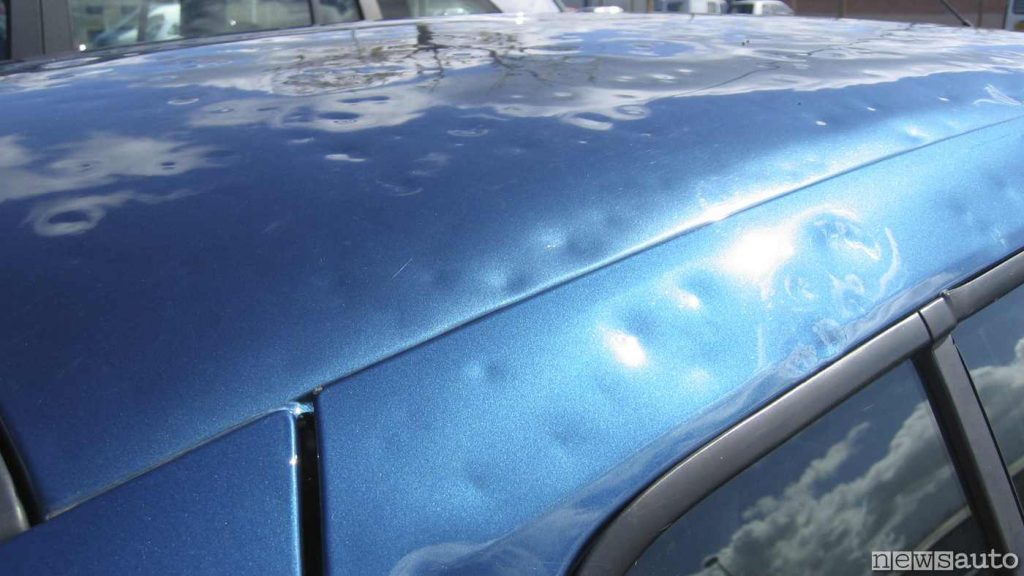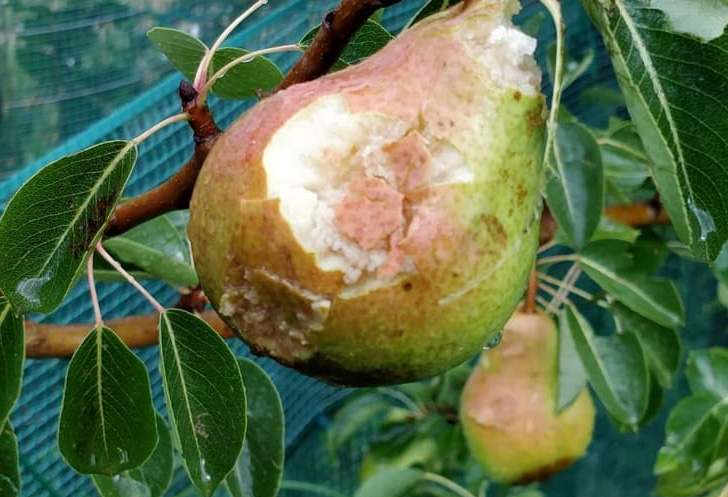There hail is a form of atmospheric precipitation characterized by ice accumulations falling from the cloud to the ground. It usually forms within strong lightning storms, during which the condensed water freezes and then turns into a real hail storm. At that point, the water droplets solidify around a nucleus, such as a speck of dust or other piece of ice in the cloud.
As frozen water droplets are raised and lowered within the cloud, layers of ice build up around the core. This process continues until the hail reaches a size that exceeds the cloud's lifting force and falls toward the ground due to gravity. Hail storms are more common in some regions of the world, especially during warm, humid seasons, when atmospheric conditions favor the formation of thunderclouds.
Hail speed and size
When hail hits the ground it can cause heavy damage: a hailstone of 10cm in diameter reaches the ground at speeds even higher than 150 km/h. In some cases, hailstones can even exceed 15/20 cm in diameter and weigh over 1 kg.
→ How to protect your car bodywork from hail
→ How to repair hail damage to your car bodywork
When hail causes damage
The damage it can cause depends on the size of the beans which can vary considerably, i.e. from small balls to ice balls of considerable size up to 20 centimetres. Hailstones can cause significant damage to buildings, crops and cars, especially when the size of the ice pieces are larger. The size of hail can vary greatly, from small ice grains to the size of a pea ice balls the size of a baseball or larger.
Damage to the bodywork
When it hits the car body at high speed, it can cause dents, scratches and cracks in the paint. Damage is usually most noticeable on the roof, hood, trunk and flat surfaces of the car, but is also found on other parts such as pillars and doors. Bumpers hold up better as they are usually made of more elastic plastic.

There severity of damage on the bodywork of a car depends on the size of the hail, the speed of fall, the angle of impact and the resistance of the car's surface. In some extreme cases, hail can even break your car's windshield or windows.
Damage to agriculture
There hail can cause significant damage to agriculture: can damage plants grown, including cereals, fruits, vegetables and industrial crops. Hail pieces can damage the leaves, flowers and fruits, causing dents, breaks or scratches. This can compromise the quality and yield of crops, reducing their commercial value. Damaged crops may experience slow growth, deform or even die, resulting in reduced supplies of food and agricultural raw materials.
For mitigate the effects of hail on agriculturefarmers can take several preventive measures, such as installing protective nets or crop insurance against damage caused by hail. Furthermore, the development of hail-resistant crop varieties and the use of appropriate agricultural practices can help reduce the negative impact of hail events on the agricultural sector.
The most severe hailstorms in the world
The most severe hailstorms recorded in the world including the one with a record maximum diameter of one 22cm hailstone:
- Hall, Texas, United States (1970): 30 May 1970, a record-sized hail storm hit the town of Hall, Texas. The pieces of hail were as large as bowling balls, causing damage estimated in millions of dollars. The hail caused the destruction of roofs, windows, vehicles and other objects, as well as causing injuries to several people.
- Goulburn, Australia (1986): January 12th 1986, a record-sized hailstorm hit the city of Goulburn, Australia. The hailstones were the size of golf balls and caused millions of dollars in damage. The hail destroyed roofs, windows, cars and other objects. It also caused injuries to several people.
- Gopalganj, Bangladesh: April 14th 1986 hail balls the size of cricket balls have been recorded, with a estimated diameter of over 22 centimetres. It is believed that it was the world record for the largest hail ever recorded.
- Montana, United States: July 20th 1995another record-sized hailstorm hit the state of Montana, in the United States: damage to cars, roofs, windows.
- Vivian, South Dakota, United States (June 22, 2010): Chunks of ice the size of baseballs and softballs were reported during this hail storm. The hail caused significant damage to crops, vehicles and property.
- Castiglione, Italy, July 27, 2013: a violent hail storm hit Northern Italy, in particular the city of Castiglione.
- Hail, China 2016: July 26th 2016a record-sized hailstorm hit the city of Hail, China.
- Kalamata, Greece, July 27, 2019: This hail storm hit the city of Kalamata in southern Greece. The sizable hail caused significant damage to cars, house roofs and crops.
These are just some of the most severe hailstorms recorded in the world. Supersized hail is rare, but hail storms can still cause significant damage in many parts of the world.
How to protect yourself from hail
When hailstones fall to the ground they can be also dangerous for people, animals, in addition to things with injuries especially to the head and neck. If a storm with hail is expected, it is important to take some precautions:
- Seek shelter indoors: The best solution to protect yourself from hail is to seek a safe place indoors, such as a house, building or a car that is likely to be damaged on the body. Avoid being outdoors during a hail storm.
- Choose solid shelter: If you don't have access to a building or car, seek shelter under solid structures like a deck, garage or sturdy gazebo. Make sure the structure is stable and does not present a risk of collapse.
- Wear protection: If you are outdoors and don't have access to shelter, you can try to protect yourself by covering your head with a hat or hooded jacket. You can also try to protect your body with a resistant material such as a rug, a sheet or a blanket.
Following these safety measures can help reduce the risk of personal injury during a hail storm. Always keep an eye on the weather forecast and, if a storm with hail is forecast, take all the advice. It is important to take the necessary precautions to protect yourself from hail.
→ How to protect the bodywork from hail
→ How to repair hail damage to your car bodywork
#Hail #forms #protect #damage

